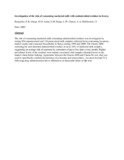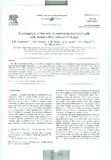| dc.contributor.author | Kang'ethe, E K | |
| dc.contributor.author | Aboge, G O | |
| dc.contributor.author | Arimi, S M | |
| dc.contributor.author | Kanja, L W | |
| dc.contributor.author | Omore, A A | |
| dc.contributor.author | McDermott, I I | |
| dc.date.accessioned | 2013-02-26T10:59:17Z | |
| dc.date.issued | 2005 | |
| dc.identifier.citation | Food Control 16 (2005) 349-355 | en |
| dc.identifier.uri | http://erepository.uonbi.ac.ke:8080/xmlui/handle/123456789/11632 | |
| dc.description.abstract | The risk of consuming marketed milk containing antimicrobial residues was investigated by testing 854 unpasteurized and 110 pasteurized milk samples collected from contrasting locations, market outlets and consumer households in Kenya during 1999 and 2000. The Charm-AIM screening kit used detected antimicrobial residues in up to 16% of marketed milk samples, suggesting an average risk of exposure by consumers of up to five times every month. Higher prevalence levels of the residues were mainly associated with samples obtained lower in the market chain before bulking. Agreement between the Charm-AIM and Charm-SL test, that was used to specifically confirm the presence of p-lactams and tetracyclines, was poor beyond 72 h following drug administration due to differences in detectable limits of the tests. | en |
| dc.language.iso | en | en |
| dc.subject | Antimicrobial residues | en |
| dc.subject | Marketed milk | en |
| dc.subject | Marketed milk | en |
| dc.title | Investigation of the risk of consuming marketed milk with antimicrobial residues in Kenya | en |
| dc.type | Article | en |
| local.publisher | Department of Public Health, Pharmacology and Toxicology | en |


